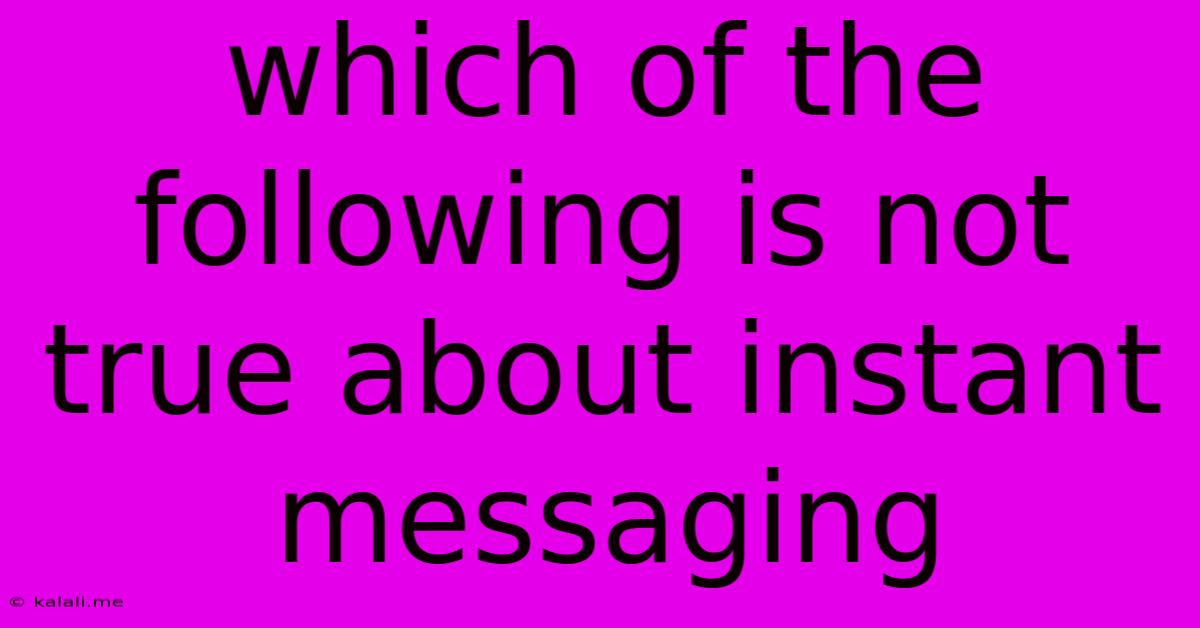Which Of The Following Is Not True About Instant Messaging
Kalali
Jun 14, 2025 · 3 min read

Table of Contents
Which of the Following is NOT True About Instant Messaging? Debunking Common Myths
Instant messaging (IM) has revolutionized how we communicate, connecting people across geographical boundaries in real-time. But despite its widespread use, some misconceptions about IM persist. This article aims to clarify these misconceptions by exploring common beliefs and identifying the statement that is not true about instant messaging. We'll delve into the features, security aspects, and overall impact of IM to provide a comprehensive understanding.
What is Instant Messaging?
Before we debunk the myths, let's establish a clear definition. Instant messaging refers to the real-time exchange of text-based messages between two or more people using the internet or a mobile network. This differs from email, which is asynchronous, meaning messages aren't delivered or read immediately. Key features of IM typically include:
- Real-time communication: Messages are delivered almost instantaneously.
- Text-based communication: Although many platforms now incorporate voice and video calls, text remains the core feature.
- User-to-user communication: The primary function is direct communication between individuals or small groups.
- Various platforms: Numerous IM platforms exist, each with its own features and user base (e.g., WhatsApp, Telegram, Messenger, etc.).
Common Beliefs About Instant Messaging: Fact vs. Fiction
Now, let's address some commonly held beliefs about instant messaging and determine which one is inaccurate:
Statement A: Instant messaging is always secure.
FALSE. This is the statement that is not true about instant messaging. While many platforms employ encryption to protect messages, no system is entirely impenetrable. Security breaches, vulnerabilities, and malicious actors pose ongoing threats. The level of security varies considerably depending on the specific platform and its implementation of security protocols. Factors like end-to-end encryption and the platform's overall security practices significantly influence the message's security. Therefore, assuming all IM is inherently secure is inaccurate.
Statement B: Instant messaging is used primarily for personal communication.
TRUE. Although IM is used in professional settings (especially for quick internal communication within companies), its dominant use remains personal communication among friends and family.
Statement C: Instant messaging facilitates quick and efficient communication.
TRUE. This is a core benefit of IM. Its real-time nature makes it ideal for quick exchanges of information and immediate responses.
Statement D: Instant messaging can be used for file sharing.
TRUE. Many IM platforms support the sharing of various file types, from documents and images to videos and audio files. This feature greatly enhances its utility beyond simple text messaging.
Statement E: Instant messaging is always free.
FALSE. While many platforms offer free services, some offer premium features or charge for advanced functionalities through subscription models.
Conclusion:
Instant messaging has become an integral part of modern communication, offering speed, efficiency, and convenience. However, it's crucial to understand its limitations, especially concerning security. The statement "Instant messaging is always secure" is demonstrably false; users should always be mindful of the security implications and choose platforms with robust security protocols and practices to minimize risks. The evolution of instant messaging continues, with ongoing improvements in security and functionality, but vigilance remains crucial for users.
Latest Posts
Latest Posts
-
Which Of The Following Is A Current Transformer
Jun 14, 2025
-
Muscle Fatigue Is Caused By
Jun 14, 2025
-
Absolute Zero Corresponds To A Temperature Of
Jun 14, 2025
-
Which Country Is Lake Victoria In
Jun 14, 2025
-
Economics Can Be Best Defined As The Study Of
Jun 14, 2025
Related Post
Thank you for visiting our website which covers about Which Of The Following Is Not True About Instant Messaging . We hope the information provided has been useful to you. Feel free to contact us if you have any questions or need further assistance. See you next time and don't miss to bookmark.